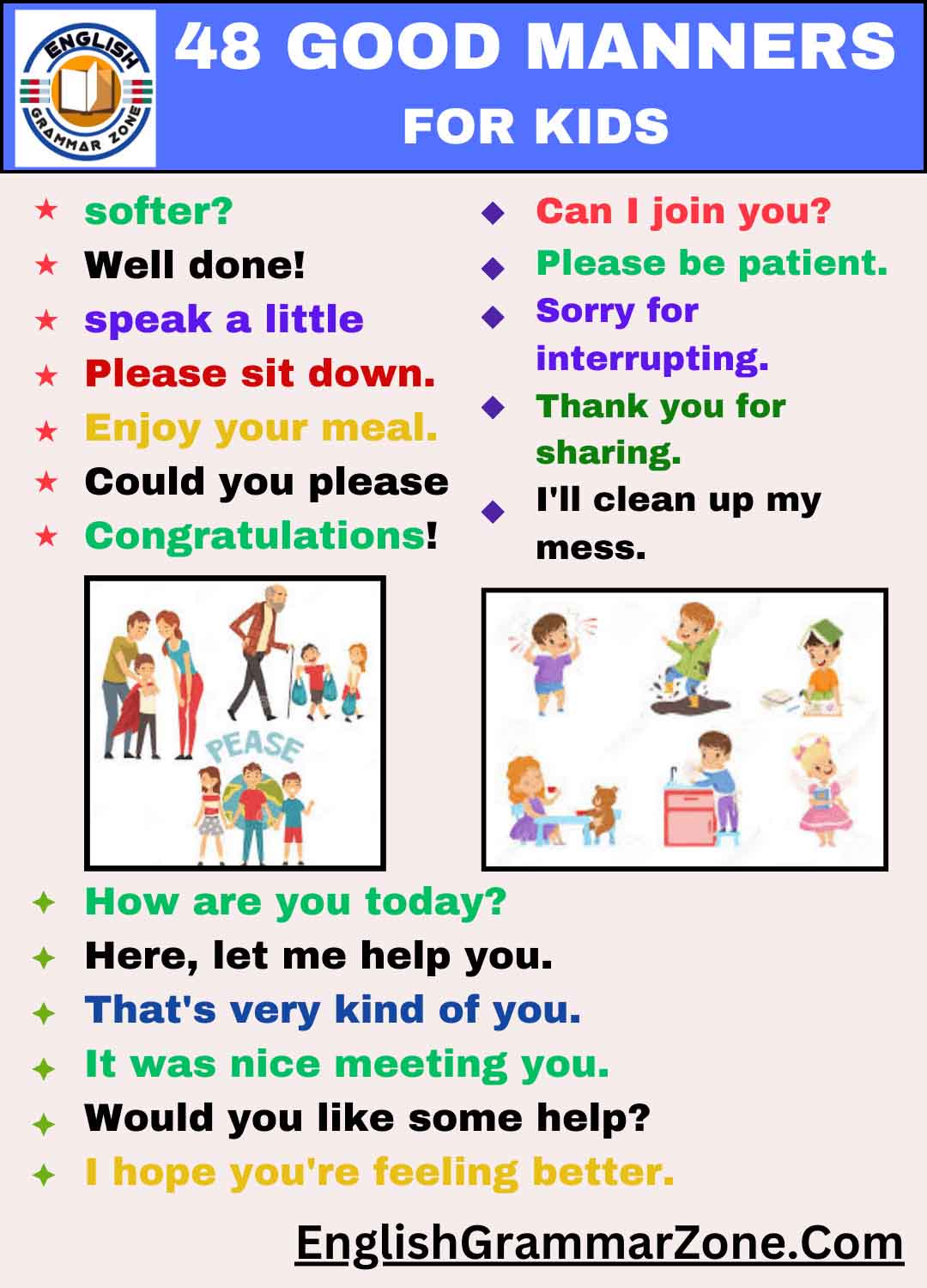Essential Good Manners for Kids: Start teaching your children these important good manners for children to help them develop respect, kindness and social skills. Everyday manners: How to teach politeness, good behavior and respect to children.
48 Essential Good Manners for Kids
- Tank you.
- You’re welcome.
- Excuse me.
- I’m sorry.
- May I?
- Can I help you?
- After you.
- Please go ahead.
- Let’s take turns.
- Good morning.
- Good afternoon.
- Good evening.
- See you later.
- Have a nice day.
- Bless you.
- Pardon me.
- I beg your pardon.
- Could you please pass the salt?
- May I have a cookie, please?
- Sure, I’d love to share.
- Would you like some help?
- Here, let me help you.
- That’s very kind of you.
- It was nice meeting you.
- How are you today?
- I hope you’re feeling better.
- Please sit down.
- Here, let me hold the door for you.
- Enjoy your meal.
- Could you please speak a little softer?
- I appreciate your help.
- Congratulations!
- Well done!
- I like your drawing.
- That was a great idea.
- Thank you for waiting.
- May I have your attention, please?
- Excuse me, I need to use the restroom.
- May I borrow your pencil?
- Could you please lower your voice?
- Can I join you?
- Sorry for interrupting.
- Please be patient.
- Thank you for sharing.
- I’m grateful for your kindness.
- I’ll clean up my mess.


Additional Tips for Teaching Essential Good Manners for Kids:
Lead by Example: Children tend to mirror their parents, so practice the good manners you wish to instill in them. Always say “please” and “thank you,” listen carefully and talk respectfully to others.
Make it a Game: Teach your kiddos good manners through fun and games. Games, role-playing or stories can help reinforce how critical good manners are in different situations.
Positive Reinforcement: Each time your child uses good manners give them positive reinforcement. Also, Use of positive reinforcement with children helps them learn that when they behave themselves, others appreciate them.
Tell them: You know that you smack that kid’s face — you’re hurting him. Teach them that being an individual that makes others feel respected and happy goes a long way when it comes to kindness and consideration.
Set Expectations — Realistic Expectations: Children cannot be expected to enumerate every rule of etiquette on the spot and will often forget them. It will take time and gentle reminders until they internalize these behaviors.
Take Advantage of Every Opportunity: Most everyday activities — eating together, answering the phone, searching for a cultural reference to a work of art, receiving guests — are perfect occasions to work on manners. These activities would also encourage him to take part in these activities with a positive attitude.
Incorporating these tips and key good manners for kids will train them for better behavior now and in their future, enabling them to become more responsible and respectful individuals.
Conclusion:
Instilling essential good manners for kids in your child is not only about following social norms, it is about a lifelong impartation of respect, kindness and empathy. These manners are the basis of good relationships, be it in school, the community or at home. By encouraging children to practice basic niceties like saying “please” and “thank you,” listening actively and being considerate, children learn the social skills that will help them thrive in different environments.
Good Manners Help Children Collect Social Debits A good manners system teaches children how to interact and helps them navigate social interactions with confidence, with a strong helping hand to create a respectful atmosphere around them. These behaviors will lay the foundation for positive friendships, the ability to navigate social norms, and peaceful conflict resolution as they develop. Such behavior must be taught and demonstrated by parents and caregivers, helping children also realize the importance of treating others with kindness and respect.
Always keep in mind that the process of teaching good manners is gradual and takes time. Be realistic about how you use it in real-life situations while applying it consistently over time. Give the children time and encouragement, they will gradually apply all these essential good manners in day to day life.

